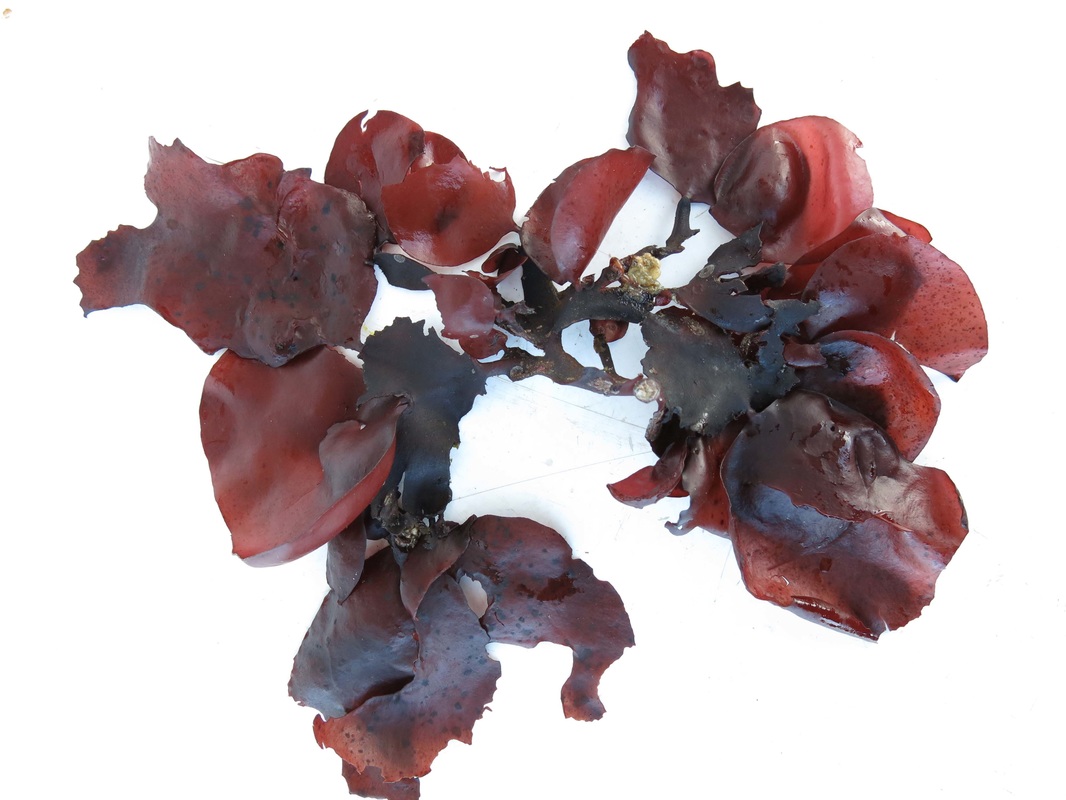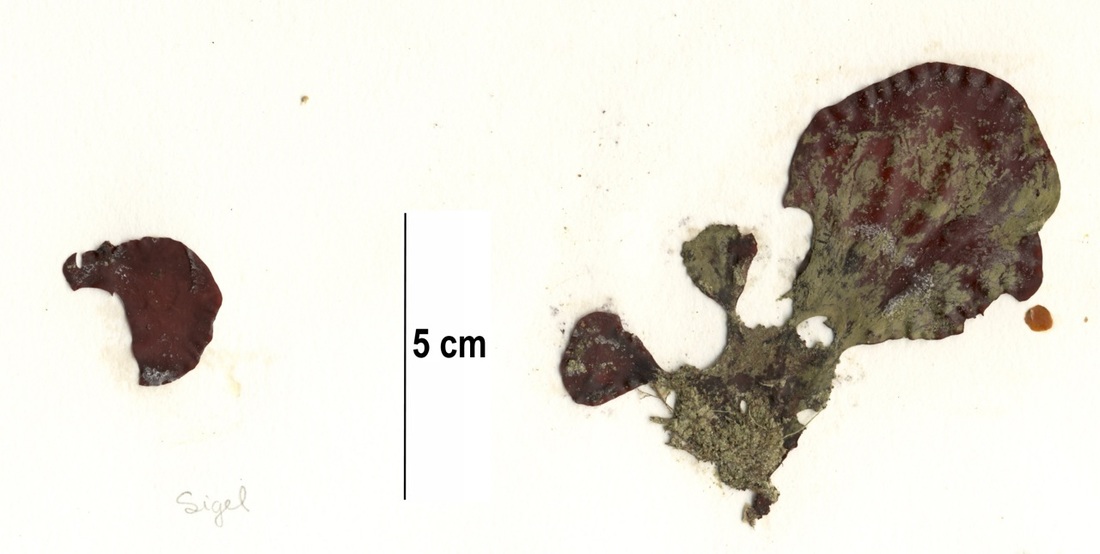Red opuntia • Opuntiella californica
|
Photos by Jenn Burt (top right) and Sandra Lindstrom. Left image is specimen collection number PTM 461 in the UBC Herbarium Algae Database; bottom right image is collection number 406. Search the specimens in the database for more information, or or search the species for further occurrences.
|
Identification
This red seaweed is easily identified by its unique branching pattern. From the margins of a single, central blade, grow numerous dark red, somewhat round blades. From the margins of these blades grow similar blades, creating a circular, rather unusual branching pattern. The blades are quite thick, and attached to a small, disc-shaped holdfast via a small stipe. This species can grow up to 20 cm in tall and 30 cm wide. At the base of some blades, you may find a faint midrib. Click here for more images.
Similar Species
Turnerella mertensiana is similar in colour and growth form. However, its lack of stipe and irregularly-shaped blades (less round) distinguish it from Opuntiella californica.
Habitat and Range
This species grows in rocky semi-protected to exposed habitats from the low intertidal to depths of 20 m. It range extends from the Aleutian Islands, Alaska to Baja California, Mexico.
This red seaweed is easily identified by its unique branching pattern. From the margins of a single, central blade, grow numerous dark red, somewhat round blades. From the margins of these blades grow similar blades, creating a circular, rather unusual branching pattern. The blades are quite thick, and attached to a small, disc-shaped holdfast via a small stipe. This species can grow up to 20 cm in tall and 30 cm wide. At the base of some blades, you may find a faint midrib. Click here for more images.
Similar Species
Turnerella mertensiana is similar in colour and growth form. However, its lack of stipe and irregularly-shaped blades (less round) distinguish it from Opuntiella californica.
Habitat and Range
This species grows in rocky semi-protected to exposed habitats from the low intertidal to depths of 20 m. It range extends from the Aleutian Islands, Alaska to Baja California, Mexico.
References
Druehl, L. 2000. Pacific Seaweeds: A guide to common seaweeds of the west coast. Harbour Publishing: Madeira Park, BC, Canada. Pp. 119.
Lamb, A., and Hanby, B. (2005). Marine Life of the Pacific Northwest [electronic version]. Madeira Park, BC: Harbour Publishing.
Lindberg, M. and Lindstrom, S. (2010). Opuntiella californica. Seaweeds of Alaska. Accessed 2015-11-0
O'Clair, R. and Lindstrom, S. Opuntiella californica (Nutt.) Haw. In Klinkenberg, Brian. (Ed.). E-Flora BC: Electronic Atlas of the Plants of British Columbia. Lab for Advanced Spatial Analysis, Department of Geography, University of British Columbia, Vancouver. Accessed 2015-11-09.
Authors and editors of page
Beatrice Proudfoot and Kelly Fretwell (2015)
Druehl, L. 2000. Pacific Seaweeds: A guide to common seaweeds of the west coast. Harbour Publishing: Madeira Park, BC, Canada. Pp. 119.
Lamb, A., and Hanby, B. (2005). Marine Life of the Pacific Northwest [electronic version]. Madeira Park, BC: Harbour Publishing.
Lindberg, M. and Lindstrom, S. (2010). Opuntiella californica. Seaweeds of Alaska. Accessed 2015-11-0
O'Clair, R. and Lindstrom, S. Opuntiella californica (Nutt.) Haw. In Klinkenberg, Brian. (Ed.). E-Flora BC: Electronic Atlas of the Plants of British Columbia. Lab for Advanced Spatial Analysis, Department of Geography, University of British Columbia, Vancouver. Accessed 2015-11-09.
Authors and editors of page
Beatrice Proudfoot and Kelly Fretwell (2015)






